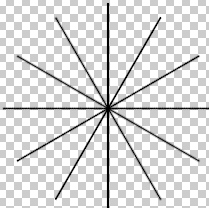- Home
- Photoshop ecosystem
- Discussions
- Re: Is it possible to change the selection angle w...
- Re: Is it possible to change the selection angle w...
Is it possible to change the selection angle with the Polygonal Lasso Tool?
Copy link to clipboard
Copied
Hi, I searched but could not find the answer, sorry if it is out there.
I'm looking to change the angle that Photoshop CC 2017 applies to the Polygonal Lasso Tool when holding Shift. It appears to snap to 45 degrees. Is there a way to change this? I'm looking to trace an Isometric design, so a 30 degree line would be ideal.
Thanks,
Tom
Explore related tutorials & articles
Copy link to clipboard
Copied
Hi Tom,
The Polygon lasso tool only lets you draw a straight line at a multiple of 45 degrees holding the Shift key as you move to click next segment,
Thanks,
Akash
Copy link to clipboard
Copied
Would it help to create a transparent layer like this (in 30 degree increments) and move it into position as a guide to drawing each line?

Copy link to clipboard
Copied
Thanks for the replies.
Well, I have the design already drawn on paper, which I can trace, I just thought that (for the sake for 100% accuracy) it'd be nice to have a tool that snaps to specific angles. I guess one way around it would be to draw the shapes as squares first and then transform them to give them a 30 degree angle. Just seems unnecessarily convoluted.
Hopefully a future update will address this!
Copy link to clipboard
Copied
Illustrator would be a better bet for this. Illy has had this feature for years:

One thing you could do in Photoshop is to scale the height of the image up to 173%, leaving the width at 100%. Any active selections must either be saved or converted to Quick Mask mode first before scaling. Now you can use the Polygonal Lasso constrained to 45 degrees to do your tracing. When done, save or convert the selections as before, and scale the height down to 58%, again leaving the width at 100%. Any 45 degree line will now be 30 degrees. This also works with the Pen tool.
Copy link to clipboard
Copied
What's your trig like? I'm thinking that turning on the grid and using relevant Adjacent and Opposite number of grid squares might work, but only for some nice round angles. You can drag the grid origin (zero, zero point) to convenient position (start of line).
Copy link to clipboard
Copied
A calculator app can help with this. Take the tangent of 30 (or whatever) degrees, and store it in the memory. Now, if you know the Width, multiply by memory recall and round off the results to get the Height. If you know the Height, divide it by memory recall and round off to get the Width.
Because of the rounding, the results will only be approximate. I have found, though, that often quite gross approximations will yield visually fine results.



